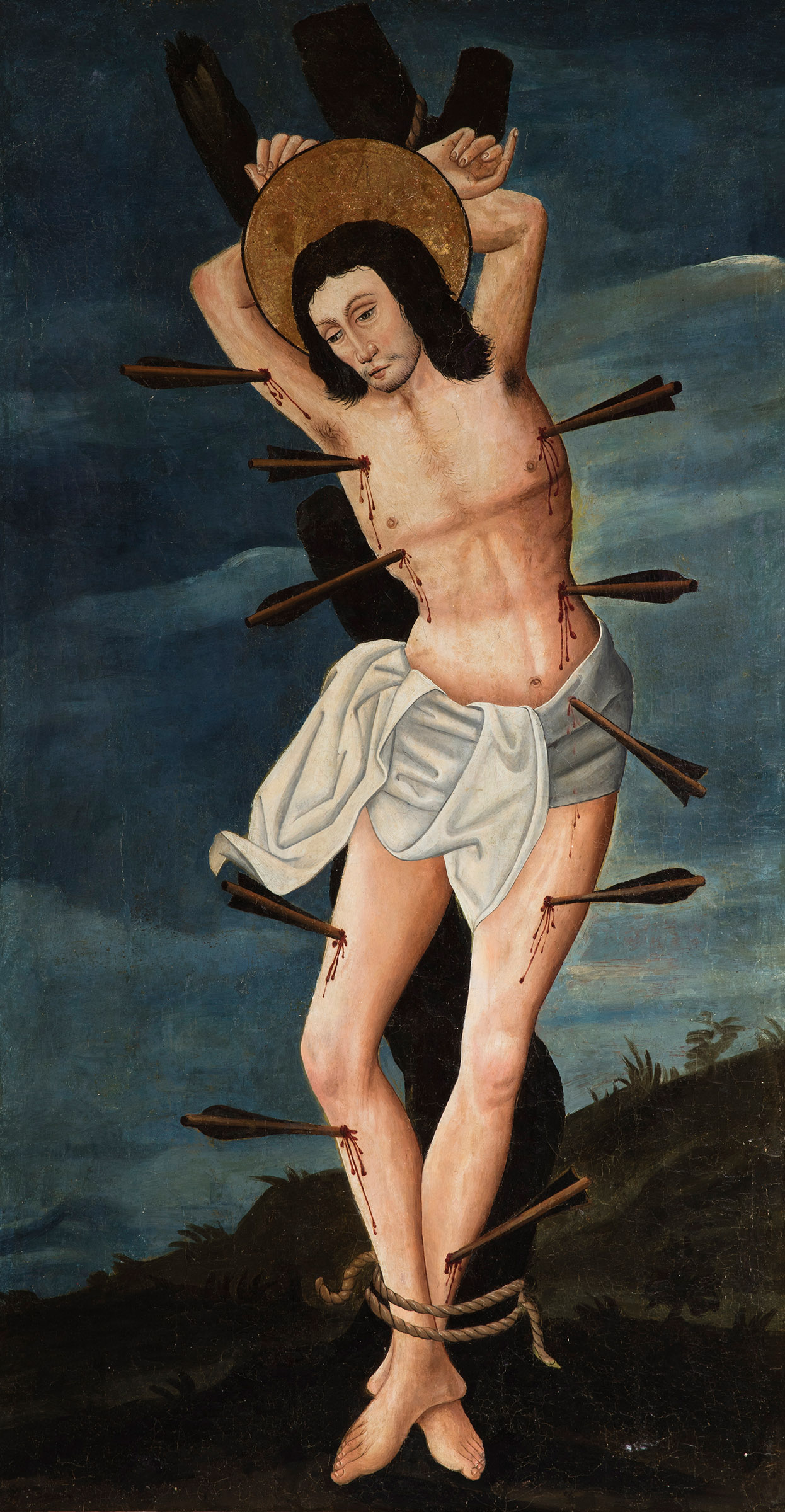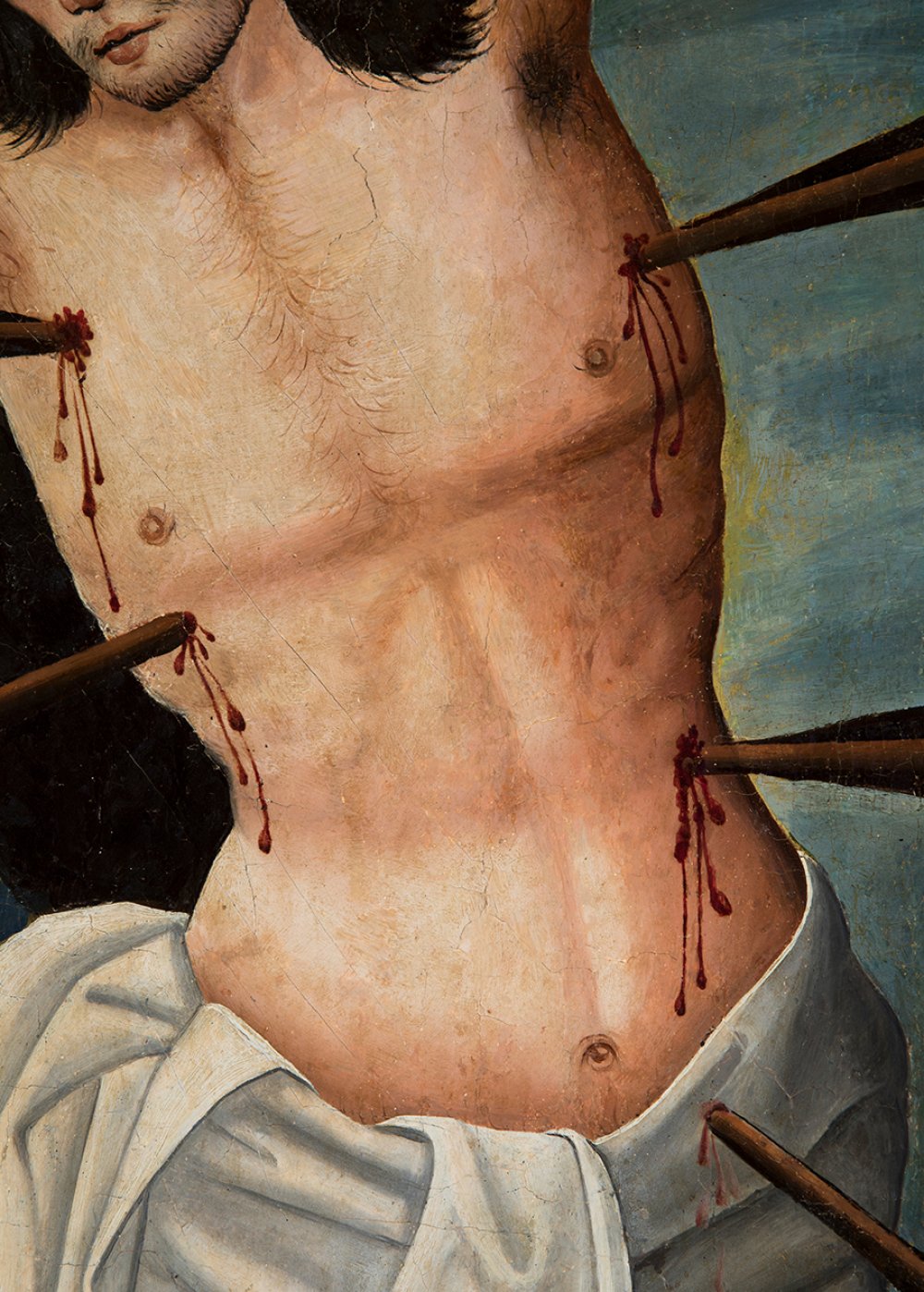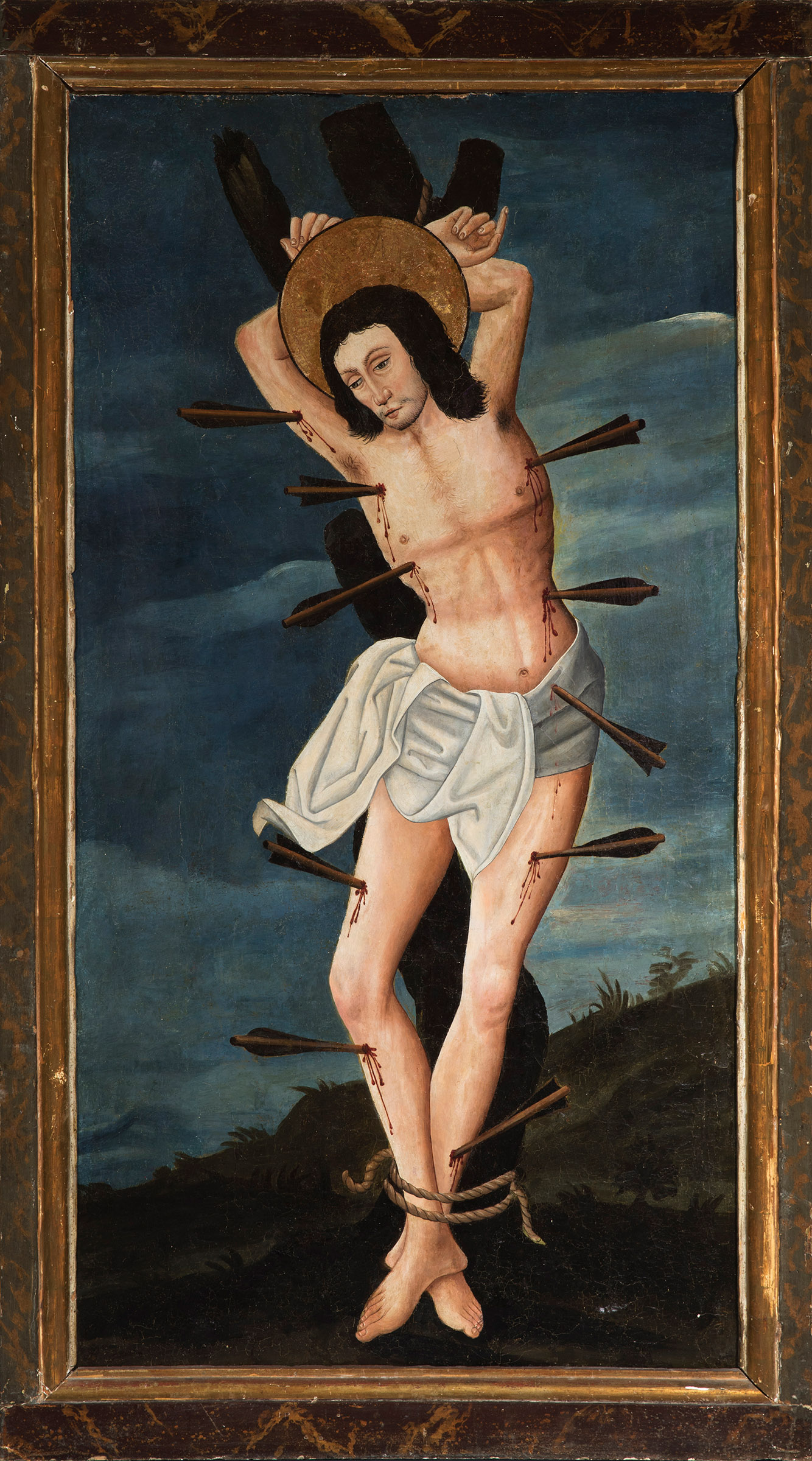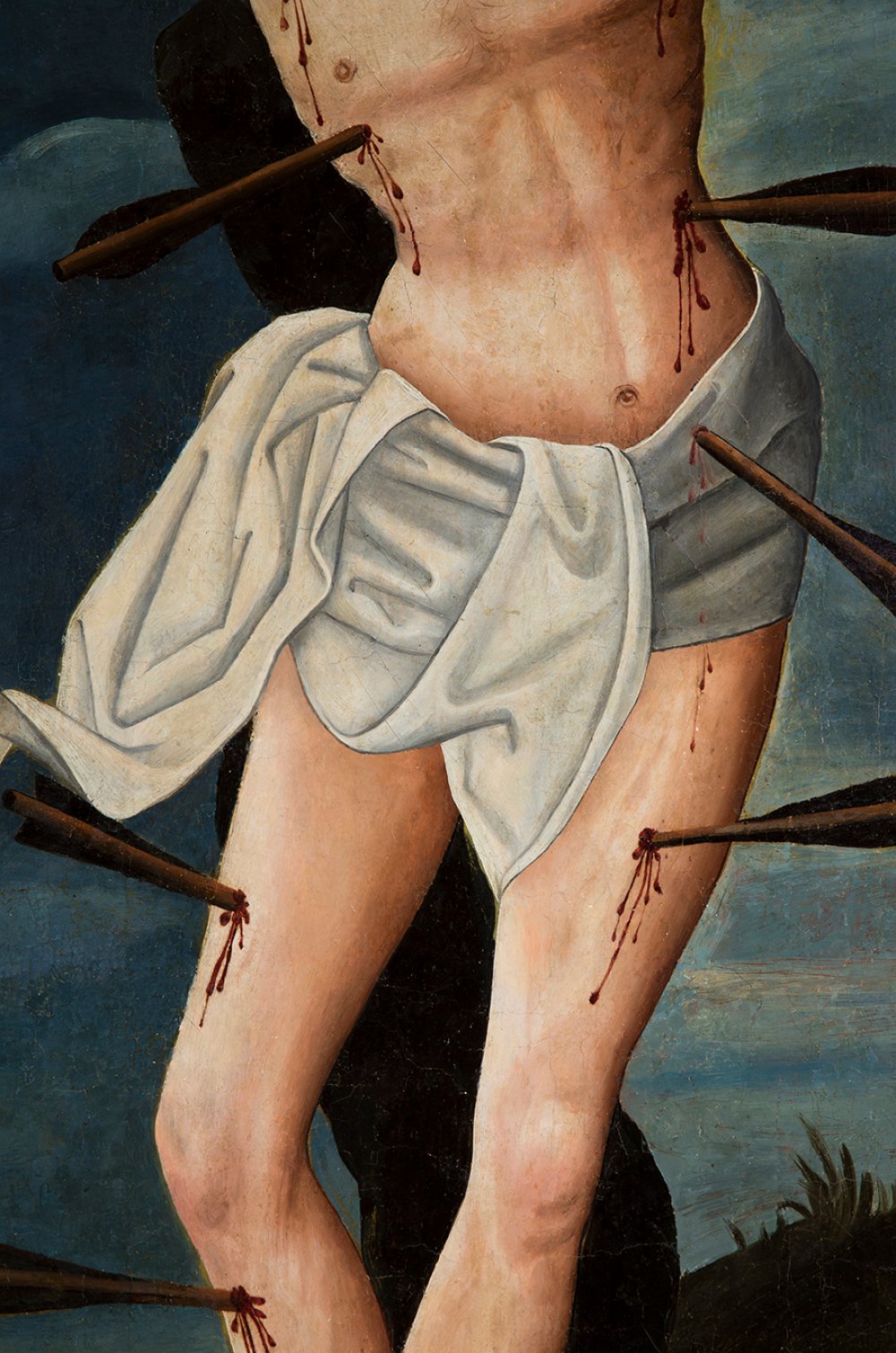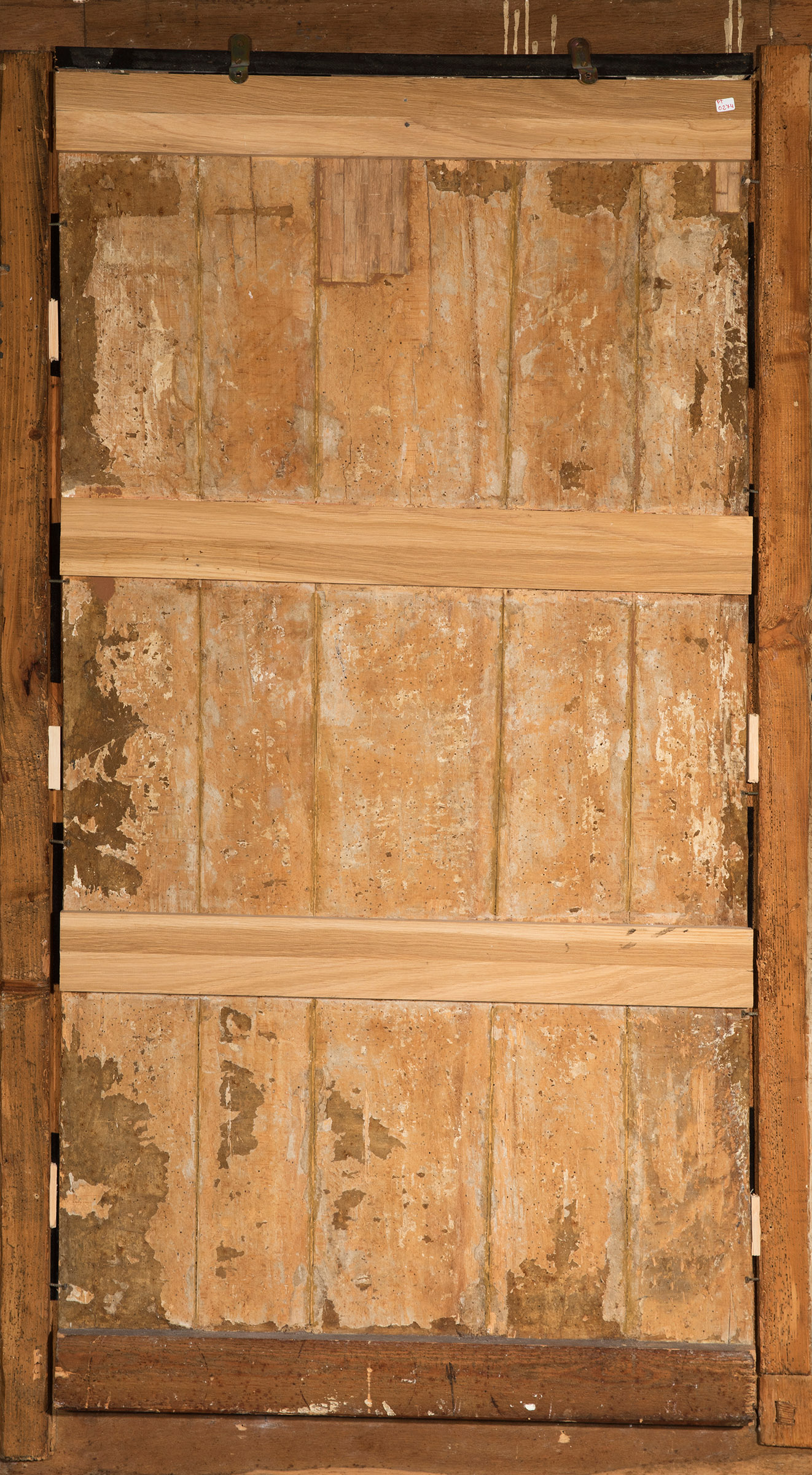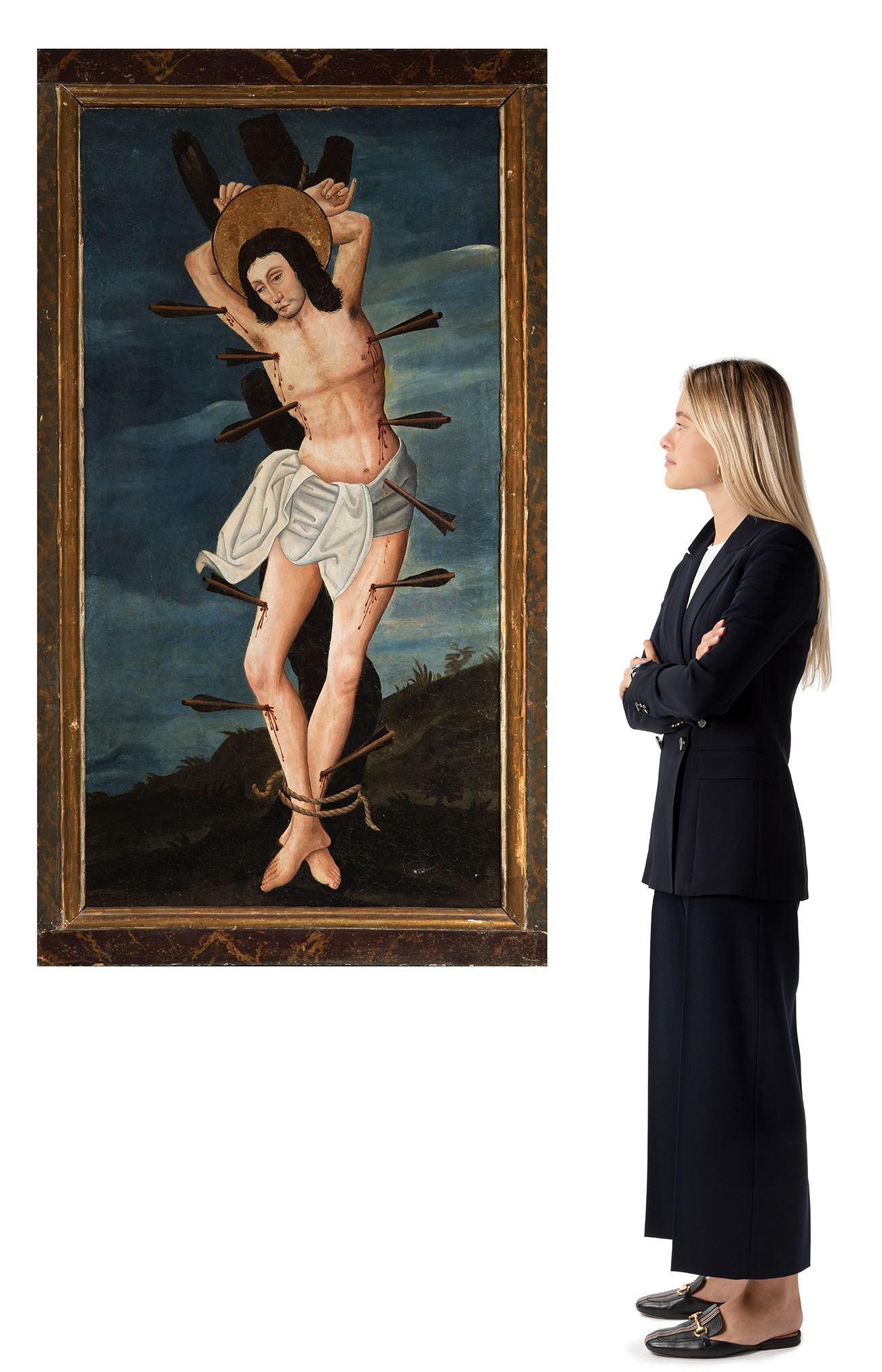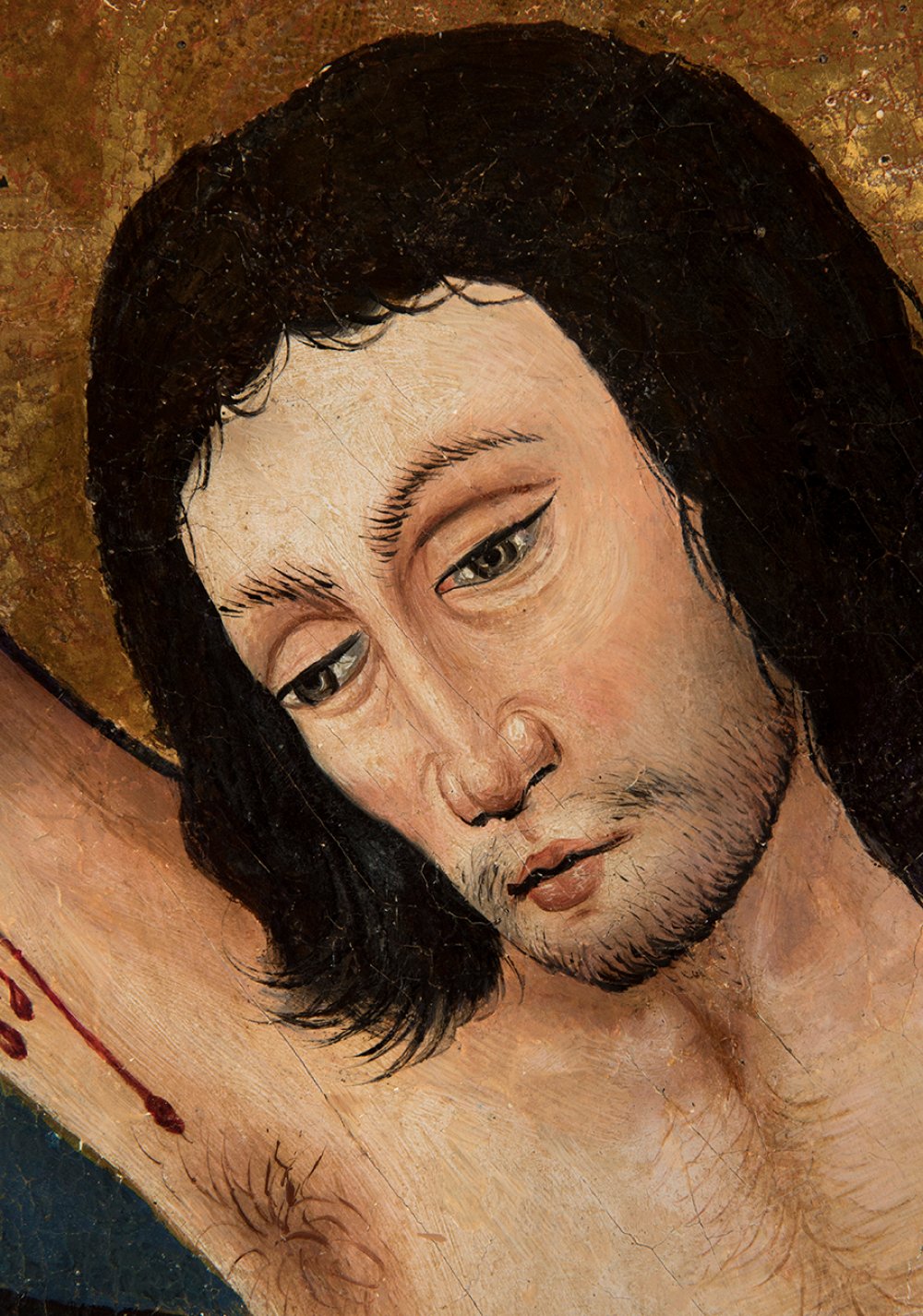46
Spanish school; late 15th century."Saint Sebastian.Oil on panel.It has numerous repainting and
"Saint Sebastian.
Oil on panel.
It has numerous repainting and restorations from a later period.
It has damage caused by xylophages.
Measurements: 135 x 70 cm; 152 x 83,5 cm (frame).
Numerous arrows are stuck in the snowy body of the main character in the scene. The treatment of the anatomy and the counter-posed posture, together with the monumentality of the figure, capture the viewer's attention, expressing great beauty in spite of the drama of the scene. The arrows that strike the flesh tones do not distort the figure, as they are placed on the sides, thus helping to further define the outline of the body. The impassive face harmonises with the calmness of the figure, with a serene gesture, the figure gazes down at the ground, accepting his martyrdom. The presence of the arrows indicates that this is a representation of Saint Sebastian. Born in Gaul and raised in Milan, Sebastian was a centurion of the first cohort in the time of the emperor Diocletian (end of the 3rd - beginning of the 4th century). Denounced because he exhorted his friends Mark and Marcellinus to remain steadfast in their faith, by order of the emperor he was tied to a post in the centre of the Field of Mars, and served as a live target for the archers who shot him. But he did not die for it. The widow Irene, who wanted to raise his body for burial, noticed that he was still breathing, bandaged his wounds and saved his life. After he was cured, he reappeared before Diocletian to reproach him for his cruelty towards the Christians. He was then scourged, beaten to death in the circus and his corpse was thrown into the Maximian sewer. Shortly afterwards, Saint Sebastian appears to Saint Lucila in her sleep to reveal to her the location of his remains, and asks her to bury him in the catacombs.
Formally, this work is already a significant advance on the international Gothic style that dominated the scene throughout Europe in the 15th century. Thus, although the line continues to play an important role, a more naturalistic depiction of the volumes and attention to detail and quality is now being sought that reflects a direct Flemish influence. However, the panel retains the full body, a device that monumentalises the figure and makes it more corporeal, losing the stylisation of the previous century. We can also see the attention to detail of Flemish origin, as can be seen in the treatment of the body hair. The anatomy evolves from Byzantine-type geometric schemes to an increasingly naturalistic modelling which, from the 15th century onwards, is mixed with a sense of pain and an emphasis on the pathetic, leading to a distortion of the figure and, frequently, to the depiction of blood. The legs are placed in a forced position, the right leg on the left and the feet joined together due to the churros. There is also a certain movement of external rotation, which usually results in the heel crossing in front of the opposite foot. As the style progresses, a greater lightness and movement in the composition will be appreciated, mainly reflected in the advancement of the knee.
"Saint Sebastian.
Oil on panel.
It has numerous repainting and restorations from a later period.
It has damage caused by xylophages.
Measurements: 135 x 70 cm; 152 x 83,5 cm (frame).
Numerous arrows are stuck in the snowy body of the main character in the scene. The treatment of the anatomy and the counter-posed posture, together with the monumentality of the figure, capture the viewer's attention, expressing great beauty in spite of the drama of the scene. The arrows that strike the flesh tones do not distort the figure, as they are placed on the sides, thus helping to further define the outline of the body. The impassive face harmonises with the calmness of the figure, with a serene gesture, the figure gazes down at the ground, accepting his martyrdom. The presence of the arrows indicates that this is a representation of Saint Sebastian. Born in Gaul and raised in Milan, Sebastian was a centurion of the first cohort in the time of the emperor Diocletian (end of the 3rd - beginning of the 4th century). Denounced because he exhorted his friends Mark and Marcellinus to remain steadfast in their faith, by order of the emperor he was tied to a post in the centre of the Field of Mars, and served as a live target for the archers who shot him. But he did not die for it. The widow Irene, who wanted to raise his body for burial, noticed that he was still breathing, bandaged his wounds and saved his life. After he was cured, he reappeared before Diocletian to reproach him for his cruelty towards the Christians. He was then scourged, beaten to death in the circus and his corpse was thrown into the Maximian sewer. Shortly afterwards, Saint Sebastian appears to Saint Lucila in her sleep to reveal to her the location of his remains, and asks her to bury him in the catacombs.
Formally, this work is already a significant advance on the international Gothic style that dominated the scene throughout Europe in the 15th century. Thus, although the line continues to play an important role, a more naturalistic depiction of the volumes and attention to detail and quality is now being sought that reflects a direct Flemish influence. However, the panel retains the full body, a device that monumentalises the figure and makes it more corporeal, losing the stylisation of the previous century. We can also see the attention to detail of Flemish origin, as can be seen in the treatment of the body hair. The anatomy evolves from Byzantine-type geometric schemes to an increasingly naturalistic modelling which, from the 15th century onwards, is mixed with a sense of pain and an emphasis on the pathetic, leading to a distortion of the figure and, frequently, to the depiction of blood. The legs are placed in a forced position, the right leg on the left and the feet joined together due to the churros. There is also a certain movement of external rotation, which usually results in the heel crossing in front of the opposite foot. As the style progresses, a greater lightness and movement in the composition will be appreciated, mainly reflected in the advancement of the knee.
26th October - Old Masters
Sale Date(s)
Venue Address
General delivery information available from the auctioneer
Setdart offers Worldwide shipping
PICK UP IN ROOM: You can come and pick up your lots in our offices (Barcelona, Madrid or Valencia). At the moment of the withdrawal, you will be able to accept the current conditions of the lot by means of a document that you will sign.
YOU CAN SEND ANOTHER PERSON TO PICK UP: This person must present a signed authorization that you can find in our web page by accessing from BUY AT SETDART- LOGISTICS-DOWNLOAD AUTHORIZATION DOCUMENT. You can also send an e-mail with the requested data in AUTHORIZATION DOCUMENT to admin@setdart.com
Important Information
25% buyer´s premium
21% buyer´s premium at www.setdart.com
Terms & Conditions
The maximum period to pay the lots is 7 working days. You can pay either via bank transfer or with credit card through our platform www.setdart.com (we only accept VISA or Mastercard).
BUYER´S PREMIUM: 22% Hammer price + 21% VAT from the buyer´s premium
If your piece has more than 100 years, our Ministry of Culture requires an export certificate in order for the piece to leave the country. Note that if the piece goes inside the EU, there is no cost for the export certificate. If the piece goes outside the EU, there is a cost for the export certificate. You can find more information in our Ministry of Culture website: https://www.culturaydeporte.gob.es/en/cultura/patrimonio/exportacionimportacion/exportacion/tasas.html
INQUIRIES: admin@setdart.com
Setdart guides you through the entire process, from the time of award to the day you receive your lot. Our logistics team will be happy to manage your transport, and will advise you on the best shipping method with professionals from the sector used to handling works of art and jewelry.
WE OFFER WORLDWIDE DOOR TO DOOR SHIPPING
PICK UP IN ROOM: You can come and pick up your lots in our offices. At the moment of the withdrawal, you will be able to accept the current conditions of the lot by means of a document that you will sign.
YOU CAN SEND ANOTHER PERSON TO PICK UP: This person must present a signed authorization that you can find in our web page by accessing from BUY AT SETDART-LOGISTICS-DOWNLOAD AUTHORIZATION DOCUMENT. You can also send an e-mail with the requested data in AUTHORIZATION DOCUMENT to admin@setdart.com
SETDART IS NOT RESPONSIBLE FOR THE STATE OF THE PARTS ONCE THEY LEAVE OUR FACILITIES. MRW SHIPMENTS: Once the payment is made, your lot will be packed for shipment, the logistics department will send you an e-mail notifying you of the day it leaves our warehouse, changes of address cannot be made after receiving this e-mail.
INSURANCE INCIDENTS: Coverage for the value of the auction up to 3000 ? per shipment, if the value of the auction is higher, Setdart will send you a quote including the additional insurance. The insurance company WILL NOT BE RESPONSIBLE FOR THE SHIPMENT THAT EXCEEDS THAT AMOUNT AND IS NOT FULLY INSURED. MRW INCIDENTS: Maximum notification 48 hours after receipt, after which the insurance company WILL NOT BE RESPONSIBLE AND NO CLAIMS WILL BE ACCEPTED.
E-MAIL LOGISTICS: logistica@setdart.com
PICK UP YOUR MESSAGES: You can send your own messaging, prior notice via e-mail that your shipment is ready, please note 3 or 4 days in advance. This type of shipment is packaged so Setdart will provide you with a quote.
EXPENSES FOR STORAGE: We inform you that if the purchased lot is not picked up within a month, you will be charged 30€ per week per lot. Setdart Online S.L., owner of the web site "setdart.com", "setdart.net" and "setdart.org", acts as a company of Spanish nationality inscribed in the Volume 36955, sheet 182, page B-293056 of the Mercantile Registry, with registered office at Calle Aragó















